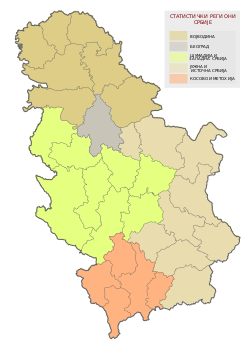Čačak
Čačak (Serbian Cyrillic: Чачак, pronounced [tʃǎːtʃak]) is a city and the administrative center of the Moravica District in central Serbia. It is located in the West Morava valley within the geographical region of Šumadija. According to the 2011 census, the city proper has 73,331 inhabitants, while the administrative area comprises a total of 115,337 inhabitants.
Čačak Град Чачак Gradac | |
|---|---|
| City of Čačak | |
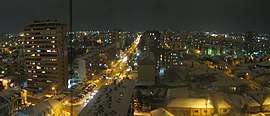  .jpg) 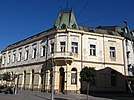 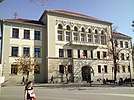  From top: Panorama at night, Bridges on West Morava, Church of Ascension of Jesus, Hotel "Belgrade", Čačak's Library, Čačak's gymnasium, National Museum | |
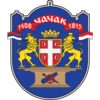 Coat of arms | |
| Etymology: frozen (or dried) mud (archaic) | |
 Čačak Location within Serbia  Čačak Location within Europe | |
| Coordinates: 43°53′N 20°21′E | |
| Country | Serbia |
| Region | Šumadija and Western Serbia |
| District | Moravica |
| Settlements | 58 |
| Government | |
| • Mayor | Milun Todorović (SNS) |
| Area | |
| Area rank | 43rd in Serbia |
| • Urban | 36.77 km2 (14.20 sq mi) |
| • Administrative | 636 km2 (246 sq mi) |
| Elevation | 242 m (794 ft) |
| Highest elevation (Ovčar) | 985 m (3,232 ft) |
| Lowest elevation | 204 m (669 ft) |
| Population (2011 census)[3] | |
| • Rank | 12th in Serbia |
| • Urban | 73,331 |
| • Urban density | 2,000/km2 (5,200/sq mi) |
| • Administrative | 115,337 |
| • Administrative density | 180/km2 (470/sq mi) |
| Time zone | UTC+1 (CET) |
| • Summer (DST) | UTC+2 (CEST) |
| Postal code | 32000 32101 32102 32103 32104 32105 |
| Area code | +381(0)32 |
| ISO 3166 code | SRB |
| Car plates | ČA |
| Climate | Cfb |
| Website | www |
Long known as a spa town, the city lies about 144 km south of the Serbian capital, Belgrade. It is also located near the Ovčar-Kablar Gorge ("Serbian Mount Athos"), with over 30 monasteries built in the gorge since the 14th century.[4][5]
Geography
Čačak is located in the western part of central Serbia, within the region of Šumadija. Once densely forested, the region is today characterized by its rolling hills and its fruit trees. To the south, past the Ovčar-Kablar Gorge, lie the mountains of the Dinaric Alps. These mountains incline in a gentle and wavy way toward the Čačak valley and the West Morava River.
The city administrative area covers 636 square kilometres (246 sq mi) and contains:
- the Čačak valley, with an altitude between 204 and 300 m (669 and 984 ft)
- hills between 300 and 500 m (980 and 1,640 ft) high
- the mountains Jelica to the south, Vujan to the northeast, and Ovčar and Kablar to the west
Climate
Čačak has an oceanic climate (Köppen climate classification: Cfb) bordering on a humid continental climate (Köppen climate classification: Dfb). The average temperature of the city and its vicinity is 10.47 °C (50.85 °F) with 74.1% humidity, and it is characterized by warm summers and cold winters. Winds blow from the north and northeast and rarely from the west because of the mountains that block them. The average temperature in August is 20.6 °C (69.1 °F), while in January it is 0.5 °C (32.9 °F). There are on average 38 days with snow during the year. The average wind speed is 2.3 metres per second (5.1 mph). The usual number of foggy days is 54. The average yearly precipitation is 802 mm (31.6 in).[6]
There are a few recorded instances of sandstorms originating in the Sahara arriving to the town.
| Climate data for Čačak | |||||||||||||
|---|---|---|---|---|---|---|---|---|---|---|---|---|---|
| Month | Jan | Feb | Mar | Apr | May | Jun | Jul | Aug | Sep | Oct | Nov | Dec | Year |
| Average high °C (°F) | 3.7 (38.7) |
6.6 (43.9) |
12.6 (54.7) |
16.5 (61.7) |
21.1 (70.0) |
24.7 (76.5) |
27.1 (80.8) |
26.8 (80.2) |
23.5 (74.3) |
17.8 (64.0) |
11.1 (52.0) |
5.4 (41.7) |
16.4 (61.5) |
| Daily mean °C (°F) | 0.1 (32.2) |
2.5 (36.5) |
7.0 (44.6) |
11.0 (51.8) |
15.5 (59.9) |
19.0 (66.2) |
21.0 (69.8) |
20.7 (69.3) |
17.8 (64.0) |
12.4 (54.3) |
6.1 (43.0) |
2.2 (36.0) |
11.3 (52.3) |
| Average low °C (°F) | −3.4 (25.9) |
−1.6 (29.1) |
1.8 (35.2) |
5.5 (41.9) |
10.0 (50.0) |
13.3 (55.9) |
14.7 (58.5) |
14.2 (57.6) |
11.0 (51.8) |
7.0 (44.6) |
2.3 (36.1) |
−1.0 (30.2) |
6.1 (43.1) |
| Average precipitation mm (inches) | 57 (2.2) |
52 (2.0) |
55 (2.2) |
64 (2.5) |
87 (3.4) |
86 (3.4) |
76 (3.0) |
61 (2.4) |
60 (2.4) |
62 (2.4) |
73 (2.9) |
69 (2.7) |
802 (31.5) |
| Source: Climate-Data.org[7] | |||||||||||||
History
Etymology
The original name of the town was Gradac (meaning "little town"), which developed around the Moravski Gradac monastery, built in the late 12th century. First mention of the name Čačak was in a document issued by the Republic of Ragusa. Dated on 3 January 1409, it refers to the events from 18 December 1408, and this date is today the official Čačak Town Day.[8][9][10]
The origin of the name is obscured today. However, several dictionaries from the 19th and even from the 20th century, including works of major linguists Vuk Stefanović Karadžić and Đuro Daničić, mention words čačak and the corresponding adjective čačkovit, meaning (lumps of) frozen or dried mud, or lumps of stone protruding from the ground. The widening along the West Morava where Čačak is located, was indeed regularly flooded until the 20th century. Daničić suggested that the origin of the word is the root skak (skakati means jumping in Serbian). The word and its variants completely disappeared from Serbian language today, but some other toponymy of the same origin were preserved, like in the name of the Čakor mountain.[8]
In time, erroneous but widespread theory developed, claiming that the name indeed means "mud", but that it is of Turkish origin. At the time of the name's first mention this region wasn't occupied by the Ottoman Empire yet, mud is called differently in Turkish language, nor there is a Turkish word corresponding vocally to čačak.[8]
Prehistoric
The region has several archaeological sites, dating from prehistory to the present, the oldest from the 15th century BC.[11]
Princely tombs of an Illyrian type (Glasinac culture) were found in two mounds of Atenica with Ionian glass, glass-paste, an amber bead depicting a swan, and an Attic plaque of a wild boar, all dating to the late 6th century BC.[12] More ornithomorphic fibulae of bronze swans were found in Mojsinje.[13][14]
Prehistoric tumuli have been unearthed in Mrčajevci.[15] The Triballi and Scordisci tribes lived in this area by the time of Roman conquest.
Roman era
The town was inhabited in Roman times, with traces of the Roman settlement still visible today, like Roman baths built in the 2nd to 4th century period. These still stand behind a secondary school in the center of Čačak.
Nearby, in the village of Gradina at the foot of the Jelica mountain, a Roman compound (fort) with a martyrium and necropolis has been excavated, with three churches, one of which produced a pentanummion for the late Roman Emperor Justinian in the 526–537 period. Justinian is also believed to have founded the fort in the 530s. The presence of burnt layers on the sight could be evidence that the settlement was destroyed in the conflict that characterized the region following the barbarian invasions of the late Roman Empire. In the same region, in the 6th century, four other forts were built.[16]
Middle Ages
Slavs settled the area during the reign of the Byzantine Emperor Heraclius (610–641). From 1168 to 1189, after incorporation into the First Bulgarian Empire and then various Serbian states, Stefan Nemanja's brother Stracimir Zavidović controlled the West Morava region, including the city, then known as Gradac. Stracimir, a Serbian župan, raised the Church of Our Lady of Moravian Gradac at the highest point of the town.
In 1459, the Turks completed their conquest of the area, incorporating it into the Sanjak of Smederevo and converting Stracimir's church into a mosque. The town's name was changed from Gradac to the current Čačak.
16th century–present
Evliya Çelebi, an Ottoman explorer of the 16th and 17th centuries, described Čačak as the main place in the local kadiluk. In 1717, Čačak became a part of the Habsburg Empire after the Austrians defeated Ottomans, signing the Treaty of Passarowitz. Austrian rule was short-lived, and 21 years later Čačak would again became a part of the Ottoman Empire. Most of Čačak's Serb residents at the time of reconquest had deserted the town, migrating north safety in the Habsburg Empire. In their stead were settlers from Montenegro, Bosnia and Hercegovina and Vlachs from the countryside nearby.
Čačak has two years on its coat of arms. The first is 1408, in which Ragusan archives first name the town. The second is 1815, the year the Second Serbian Uprising began and the year the Battle of Ljubić was fought in the hills near Čačak. This battle is famous for one of the greatest Serbian rebel victories. Then a small group, the rebels defeated a much stronger Ottoman army numbering 5,000–12,000 men. Soon after, the Principality of Serbia, one of the first nations liberated from Ottoman rule, secured its independence.
In 1837, one of the first Serbian grammar schools was completed. In the 1837–1941 period Čačak gradually modernized, with its town center modeled in a Vienna Secession style popular at the time and standing to this day. During World War II, Čačak was part of the short-lived Republic of Užice, which, while the first liberated territory in Europe, was cut off by German forces shortly after it was founded. On 4 December 1944 Čačak was finally liberated by the Yugoslav Partisans. It has since evolved into a large town and a regional center, later being given the official status of a city within today's Republic of Serbia.
Settlements
Aside from the urban area of the city, the administrative area includes the following 58 settlements:
- Atenica
- Baluga (Ljubićska)
- Baluga (Trnavska)
- Banjica
- Beljina
- Bečanj
- Brezovica
- Bresnica
- Vapa
- Vidova
- Viljuša
- Vranići
- Vrnčani
- Vujetinci
- Goričani
- Gornja Gorevnica
- Gornja Trepča
- Donja Gorevnica
- Donja Trepča
- Žaočani
- Zablaće
- Jančići
- Ježevica
- Jezdina
- Katrga
- Kačulice
- Konjevići
- Kukići
- Kulinovci
- Lipnica
- Loznica
- Ljubić
- Međuvršje
- Milićevci
- Miokovci
- Mojsinje
- Mrčajevci
- Mršinci
- Ovčar Banja
- Ostra
- Pakovraće
- Parmenac
- Petnica
- Preljina
- Premeća
- Pridvorica
- Prijevor
- Prislonica
- Rajac
- Rakova
- Riđage
- Rošci
- Slatina
- Sokolići
- Stančići
- Trbušani
- Trnava
Demographics
| Year | Pop. | ±% p.a. |
|---|---|---|
| 1948 | 70,032 | — |
| 1953 | 75,485 | +1.51% |
| 1961 | 85,439 | +1.56% |
| 1971 | 97,924 | +1.37% |
| 1981 | 110,801 | +1.24% |
| 1991 | 116,808 | +0.53% |
| 2002 | 117,072 | +0.02% |
| 2011 | 115,337 | −0.17% |
| Source: [17] | ||
The city's administrative area or municipality has 115,337 inhabitants, with 73,331 living in Čačak proper.
The city of Čačak has 38,590 households with 2.99 members on average. The number of homes is 51,482.[18]
The city's religious structure is predominantly Serbian Orthodox (110,281), with minorities including atheists (577), Catholics (168), Muslims (73), Protestants (21) and others.[19] Virtually the entire population speaks the Serbian language (112,505).[19]
The composition of population by gender and average age:[19]
- Male – 55,995 (41.42 years) and
- Female – 59,342 (43.95 years).
A total of 53,543 citizens older than 15 have a secondary education (54.01%), while 14,823 citizens have some sort of tertiary education (14.95%). Of those with a tertiary education, 9,386 (9.47%) have university education.[20]
Ethnic groups
The city is mostly inhabited by Serbs (95.3%), followed by minorities of Roma, Montenegrins and other ethnic groups.
Being located on a crossroads between the Ottoman Empire and Austria-Hungary during the 19th century, Čačak was home even to people of ethnicities that were not common in Čačak's region. One such example was a small Armenian community which began to settle from 1885, fleeing the forcible draft into the Ottoman army and the general oppression against the Armenians in the empire.[21] Most members of this community worked in the coffee business. By the 1950s most of them had emigrated as the new Communist authorities, in the massive process of nationalization after World War II, confiscated Armenian businesses.[21]
The ethnic composition of the city is given in the following table (as of 2011 census):[22]
| Ethnic group | Population | % |
|---|---|---|
| Serbs | 110,886 | 96.14% |
| Roma | 530 | 0.46% |
| Montenegrins | 328 | 0.28% |
| Croats | 105 | 0.09% |
| Yugoslavs | 117 | 0.10% |
| Macedonians | 112 | 0.10% |
| Russians | 34 | 0.03% |
| Others | 3,225 | 2.80% |
| Total | 115,337 |
Society and culture
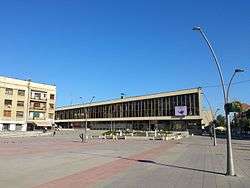
This city traversed a long and thorny road from an anonymous settlement to a modern city in the 21st century. The very face of the city, as seen in the facades, monuments, and cultural establishments, is the reflection of the artistic spirit of its inhabitants.
During the theatrical season there are numerous theatrical ensembles on tour from all of Serbia at cultural centre Dom kulture Čačak. Centre is home to "Drama Studio" and schools of ballet, fine art and sculpture. The exhibitions and performances, cultural and literary evenings are held at numerous places such as: "City Library Čačak", "Nadežda Petrović" and "Risim" galleries, "National Museum" in Čačak, "Salon of Photography" and "Inter-Municipal Archive" among many others. The current artwork production in the city can be followed through the auspices of groups and associations, private galleries, colonies and numerous enthusiasts.[23]
Fine art and sculpture colonies are most often held at the Ovčar Banja spa resort. There are numerous cultural, musical, entertainment and tourist manifestations within the city and close surroundings, which attract multitudes of followers of ethno-culture, original folk music, like the "Dis spring",[24] Memorial to Nadežda Petrović and the "Flute festival" in the nearby village of Prislonica.[25] Also, newly established festivals "DUK Festival" and rock festival "Priča" attract younger population from the city and its region.[26][27][28] Čačak is also home to events such as "Pitijada", "Kupusijada", "Fijakerijada" and other festivals that celebrate old traditions belonging to Serbs.[29]
In Guča, 10 kilometres (6.2 mi) south from Čačak, every year the Guča trumpet festival is held, one of the most popular festivals in the Balkans, alongside the Exit festival in (Novi Sad).
Education
There are three faculties located in Čačak; two of them are a part of the University of Kragujevac:
- Faculty of Agronomy
- Faculty of Technical Sciences
- Higher Technical School of Professional Studies
There are seven secondary schools:
- Čačak's Grammar School (one of the oldest grammar schools in Serbia, 1837)
- High School of Economics
- Technical High School
- Medicine High School
- Machine High School
- Musical High School
- F&C School
There are many primary schools and childcare centers.
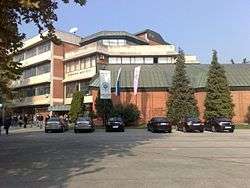
 Čačak's Grammar School
Čačak's Grammar School High School of Economics
High School of Economics- Technical High School
 Musical High School
Musical High School
Sports

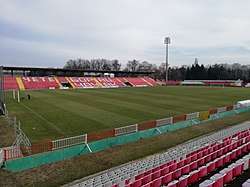
The "Mladost Sports Center" which is located on the coast of West Morava River, next to the Čačak Stadium, two faculties and numerous other important buildings, offers many sports venues for locals.[30] The whole area where the Sports Center is located is the town's most important entertainment area.[30]
Čačak is nationally famous for its clubs in various team sports; the most popular ones are basketball, football and handball. The basketball club Borac Čačak and football club Borac Čačak have been participating in the top-tier leagues of Serbia for many consecutive years with much success. Women's handball is also very successful and popular.
Tourism
In the vicinity of Čačak there are more than 20 churches and monasteries, the largest number found on such a small area in Serbia. They represent cultural and historic monuments of great significance. The most important ones are the Church of the Ascension of Jesus, a church on Ljubić hill dedicated to Saint Tsar Lazar, as well as the Vujan Monastery located on a nearby mountain of the same name. Special value is attributed to the monasteries of the Ovčar-Kablar Gorge, which as a cultural and historic whole date back to the Middle Ages and represent the particularity of the region's cultural and artistic heritage created over the centuries. There are 12 monasteries and churches in the gorge:
- Uspenje
- Vavedenje
- Jovanje
- Nikolje
- Blagoveštenje
- Vaznesenje
- Preobraženje
- Sretenje
- Sveta Trojica
- Ilinje
- Savinje
- Kadjenica
Thermal and mineral springs with medicinal properties provide the basis for the development of recreational tourism. There are three spa resorts within the territory of the city of Čačak: Gornja Trepča, Ovčar Banja and Slatinska Banja. There are also picnic sites: Gradina and the "Battle and victory" park (also called "Spomen" (remembrance) park) on the Jelica mountain, the Memorial complex on Ljubić hill, Grujine fields, rafts on West Morava river in Beljina, Parmenac, Međuvršje and Ovčar Banja, and picnic sites on the tiny rivers called Dičina, Kamenica, Čemernica and Banja.
Image gallery
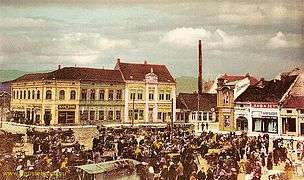 Čačak at the beginning of 20th century
Čačak at the beginning of 20th century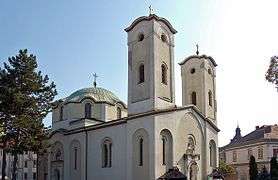 Church of Ascension of Jesus
Church of Ascension of Jesus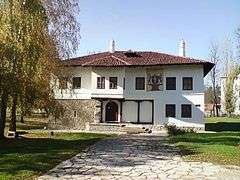 National museum in Čačak
National museum in Čačak Church of Saint Tsar Lazar on Ljubić hill
Church of Saint Tsar Lazar on Ljubić hill Bridges on West Morava river and Borac hall
Bridges on West Morava river and Borac hall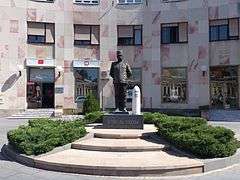 Monument to Stepa Stepanović
Monument to Stepa Stepanović.jpg) View on Ljubić from West Morava in winter
View on Ljubić from West Morava in winter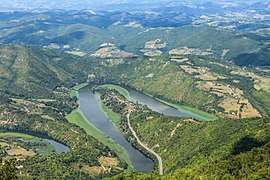 West Morava meanders in Ovčar-Kablar Gorge
West Morava meanders in Ovčar-Kablar Gorge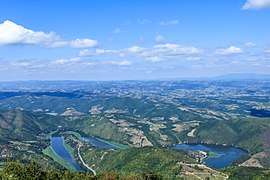 West Morava meanders in Ovčar-Kablar Gorge
West Morava meanders in Ovčar-Kablar Gorge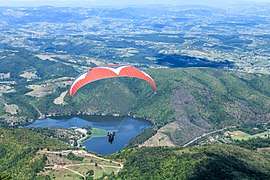 Paragliding over Ovčar-Kablar Gorge
Paragliding over Ovčar-Kablar Gorge- KK Borac Sports Hall
Economy
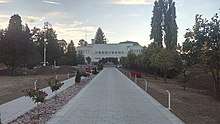
The structure of the economy of the city of Čačak is composed of services and trade, industry and agriculture. The main processing industries are paper production, electric home appliances, blade tools for the processing of metal, non-metals, chemical industry products, thermal technical appliances, metal and combined carpentry, parts and kits for the pharmaceutical industry and products for medical needs. Also, well developed are wood, lumber industry and agriculture.
Many companies with more than 250 employees have deteriorated due to the sanctions in the 1990s. Since 2000, more than 40 government-owned companies have gone through the privatization process.[31]
Private enterprise, which has its tradition from back in the 19th century, is the primary characteristic of the economy of the city. As of January 2017, 98.65% of all business enterprises are small and micro companies.[32] A large number of private companies grew into middle-size companies with 80 to 270 employees offering a wide variety of products.[33] Today, on the territory of the city of Čačak, among the largest employers are Sloboda Čačak, Technical Overhaul Military Institute (Remont), Hospital Čačak, Fabrika reznog alata and P.S. Fashion. Čačak also has the prestigious and country's unique Fruit Research Institute located in city center zone.
For the 2017 calendar year, business enterprises in Čačak imported the goods in value of 269 million euros, and exported goods in value of 171 million euros.[34] The coverage of imports by exports was 64%.[34]
- Economic preview
The following table gives a preview of total number of registered people employed in legal entities per their core activity (as of 2019):[35]
| Activity | Total |
|---|---|
| Agriculture, forestry and fishing | 190 |
| Mining and quarrying | 107 |
| Manufacturing | 10,470 |
| Electricity, gas, steam and air conditioning supply | 370 |
| Water supply; sewerage, waste management and remediation activities | 423 |
| Construction | 1,251 |
| Wholesale and retail trade, repair of motor vehicles and motorcycles | 7,179 |
| Transportation and storage | 3,029 |
| Accommodation and food services | 1,595 |
| Information and communication | 639 |
| Financial and insurance activities | 570 |
| Real estate activities | 101 |
| Professional, scientific and technical activities | 985 |
| Administrative and support service activities | 1,089 |
| Public administration and defense; compulsory social security | 1,414 |
| Education | 2,180 |
| Human health and social work activities | 2,188 |
| Arts, entertainment and recreation | 506 |
| Other service activities | 511 |
| Individual agricultural workers | 664 |
| Total | 35,461 |
Transportation
Railways in Čačak | ||||||||||||||||||||||||||||||||||||||||||||||||||||||||||||||||||||||||||||||||||||||||||||||||||||||||||||||||||||||||||||||||||||||||||||
|---|---|---|---|---|---|---|---|---|---|---|---|---|---|---|---|---|---|---|---|---|---|---|---|---|---|---|---|---|---|---|---|---|---|---|---|---|---|---|---|---|---|---|---|---|---|---|---|---|---|---|---|---|---|---|---|---|---|---|---|---|---|---|---|---|---|---|---|---|---|---|---|---|---|---|---|---|---|---|---|---|---|---|---|---|---|---|---|---|---|---|---|---|---|---|---|---|---|---|---|---|---|---|---|---|---|---|---|---|---|---|---|---|---|---|---|---|---|---|---|---|---|---|---|---|---|---|---|---|---|---|---|---|---|---|---|---|---|---|---|---|
| ||||||||||||||||||||||||||||||||||||||||||||||||||||||||||||||||||||||||||||||||||||||||||||||||||||||||||||||||||||||||||||||||||||||||||||
Due to its geographical position, Čačak is the main road transportation center in Western Serbia. As of August 2019, Miloš the Great motorway, which is projected to run from Belgrade to border with Montenegro, is in service from Obrenovac to Čačak with several other sections currently under construction.[36] Also, the A5 motorway is planned and it will run from Čačak to Pojate, thus connecting two main motorways in Serbia. Čačak also lies on State Road 22 and State Road 23, two main highways in Western Serbia.
A railway from Kraljevo to Požega passes through Čačak, thus connecting the city with Belgrade–Bar railway (one of country's main railways). The Morava Airport, one of country's three international airports, was opened in 2019 for civil airplanes and is located between Čačak and Kraljevo.
 A2 motorway section near Čačak
A2 motorway section near Čačak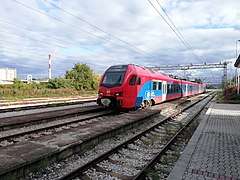 Srbija Voz train arriving at Čačak railway station
Srbija Voz train arriving at Čačak railway station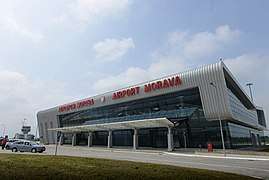 Nearby Morava Airport
Nearby Morava Airport
Notable people
- Boban Dmitrović, football player
- Bora Đorđević, rock musician
- Branko Jelić, football player
- Darko Lazović, football player
- Dragan Kićanović, former basketball player and coach, Olympic, World and European champion
- Dragomir Čumić, actor
- Dragutin Gavrilović, military officer († 1945)
- Dušan Markešević, athlete
- Hadži Prodan Gligorijević, leader of the Hadži Prodan's Revolt († 1825)
- Ivan Stambolić, politician († 2000)
- Ivan Stevanović, football player
- Ivica Dragutinović, football player
- Filip Filipović, mathematician, revolutionary, first secretary of Communist party of Yugoslavia
- Filip Mladenović, football player
- Lazar Marković, football player
- Luke Black, pop singer
- Marko Lomić, football player
- Marko Marinović, basketball player
- Milan Jovanović, Montenegrin football player
- Milan Stojadinović, politician († 1961)
- Milivoje Vitakić, football player
- Miloš Minić, politician († 2003)
- Milovan Destil Marković, artist
- Milovan Rajevac, football coach
- Midorag Radovanović, actor
- Miroslav Ilić, folk singer
- Mladomir Puriša Đorđević, film director and screenwriter
- Momčilo Perišić, general
- Nadežda Petrović, painter († 1915)
- Nemanja Kojić, athlete
- Serbian Patriarch Irinej, head of the Serbian Orthodox Church
- Petar Stambolić, politician († 2007)
- Predrag Koraksić Corax, caricaturist
- Radisav Ćurčić, former basketball player
- Radmila Bakočević, soprano
- Radojko Avramović, football coach
- Radomir Mihailović Točak, rock guitarist
- Robert Kišerlovski, road bicycle racer
- Sonja Savić, actress († 2008)
- Stepa Stepanović, general from Balkan Wars and World War I († 1929)
- Stracimir Zavidović, 12th-century Serbian noble that ruled West Morava († after 1189)
- Tadija Dragićević, basketball player
- Tanasko Rajić, captain in Second Serbian Uprising († 1815)
- Tatomir Anđelić, mathematician († 1993)
- Uroš Tripković, basketball player
- Velimir Ilić, politician
- Vera Matović, folk singer
- Vlada Jovanović, basketball coach
- Vladan Vasilijević, politician and specialist in criminal law
- Vladislav Petković Dis, poet († 1917)
- Željko Obradović, former basketball player and coach, Olympic silver medalist, World, European and eight-time Euroleague champion
- Zoran Kostić (footballer), football player
- Petar Krsmanović, volleyball player, European champion
International relations
Twin towns and sister cities
Čačak is twinned with:
|
See also
- List of places in Serbia
- Ozon Radio
References
- "Municipalities of Serbia, 2006". Statistical Office of Serbia. Retrieved 28 November 2010.
- "Насеља општине Чачак" (PDF). stat.gov.rs (in Serbian). Statistical Office of Serbia. Retrieved 12 October 2019.
- "2011 Census of Population, Households and Dwellings in the Republic of Serbia: Comparative Overview of the Number of Population in 1948, 1953, 1961, 1971, 1981, 1991, 2002 and 2011, Data by settlements" (PDF). Statistical Office of Republic Of Serbia, Belgrade. 2014. ISBN 978-86-6161-109-4. Retrieved 27 June 2014.
- "Srpska Sveta Gora". Politika (in Serbian). 1 September 2006.
- sr:Ovčarsko-kablarski manastiri
- "Čačak – geographical position". TurizamCacak.org.rs. Archived from the original on 30 May 2011. Retrieved 22 April 2017.
- "Climate: Čačak, Serbia". Climate-Data.org. Retrieved 13 February 2018.
- Rodoljub Petrović (26 July 2017). Порекло и значење имена нашег града: Чачак је српска реч [Origin and meaning of our town's name: Čačak is Serbian word] (in Serbian). Čačanski Glas.
- Gvozden Otašević (2 March 2008). "Šest vekova Čačka" [Six centuries of Čačak]. Politika (in Serbian).
- Srboljub Đ. Stamenković, Dragica Gatarić (2002). Srboljub Đ. Stamenković (ed.). Географска енциклопедија насеља Србије, IV том, С-Ш, стр. 285 [Geographical encyclopedia of the settlements of Serbia, Vol. IV, S-Š, page 286]. University of Belgrade Faculty of Geography, Belgrade.
- "直の日記". To-Cacak.com. Retrieved 22 April 2017.
- Trebenishte: the fortunes of an unusual excavation – M. Stibbe, Rastko Vasić
- http://sehumed.uv.es/revista/numero16/SEHUMED_colecc131.PDF
- [hrcak.srce.hr/file/71455 srce.hr]
- Petrova, Ekaterina. "Balkan Travellers – Archaeologists Discover Pre-Historic Tumuli in Central Serbia". BalkanTravellers.com. Archived from the original on 23 April 2017. Retrieved 22 April 2017.
- at Google Books
- "2011 Census of Population, Households and Dwellings in the Republic of Serbia" (PDF). stat.gov.rs. Statistical Office of the Republic of Serbia. Retrieved 11 January 2017.
- "Number and the floor space of housing units" (PDF). stat.gov.rs (in Serbian). Statistical Office of the Republic of Serbia. Retrieved 21 March 2018.
- "Religion, Mother tongue, and Ethnicity" (PDF). stat.gov.rs (in Serbian). Statistical Office of the Republic of Serbia. Retrieved 21 March 2018.
- "Educational attainment, literacy and computer literacy" (PDF). stat.gov.rs (in Serbian). Statistical Office of the Republic of Serbia. Retrieved 21 March 2018.
- Gvozden Otašević (9 April 2018). "Ljudi kojima je "ić" bilo spasenje" [People for whom "ić" was a salvation]. Politika (in Serbian).
- "ETHNICITY Data by municipalities and cities" (PDF). stat.gov.rs. Statistical Office of Serbia. Retrieved 1 March 2018.
- "- :: Grad Čačak ::". Cacak.org.rs. Retrieved 22 April 2017.
- "Disovu nagradu za 2019. godinu dobio je pesnik Đorđo Sladoje". danas.rs (in Serbian). Beta. 13 March 2019. Retrieved 17 May 2019.
- "31. Сабор фрулаша Србије "Ој, Мораво"". rts.rs (in Serbian). 4 February 2019. Retrieved 17 May 2019.
- "DUK još jednom dovodi svet na Moravu". danas.rs (in Serbian). 16 May 2019. Retrieved 17 May 2019.
- "Овогодишња "ПриЧА" помериће границе". glaszapadnesrbije.rs (in Serbian). 25 July 2019. Retrieved 26 July 2019.
- "Festival PriČa: Parni valjak, Hladno pivo, Zabranjeno pušenje i još mnogo bendova stiže u Čačak" (in Serbian). 24 August 2019. Retrieved 25 August 2019.
- Nikitović, V. "KUPUSIJADA U MRČAJEVCIMA Manifestaciju otvara ministar Nedimović, Oliveri Katarini priznanje za životno delo". blic.rs (in Serbian). Retrieved 17 May 2019.
- Veselinović, Stefan (17 August 2019). "Čačak: Kako je volonterizam mladih dao nov život obali Morave". bbc.com (in Serbian). Retrieved 25 August 2019.
- "U Čačku još dva velika preduzeća nisu privatizovana – "Fabrika reznih alata" i "Sloboda"". ekapija.com (in Serbian). Retrieved 30 March 2015.
- "U Čačku posluje 6.113 firmi i preduzetničkih radnji". moravainfo.rs (in Serbian). 14 January 2017. Retrieved 24 January 2018.
- "- :: Grad Čačak ::". Cacak.org.rs. Retrieved 22 April 2017.
- "Iz Čačka najviše u EU i zemlje bivše YU". b92.net (in Serbian). Beta. 4 February 2018. Retrieved 29 March 2018.
- "Запослени у Републици Србији, 2019. - Годишњи просек -" (PDF). stat.gov.rs (in Serbian). Statistical Office of Republic of Serbia. 31 January 2020. Retrieved 15 March 2020.
- "Svečano otvoren auto-put "Miloš Veliki", Vučić kaže - put za ponos cele Srbije". n1info.com (in Serbian). Beta, FoNet. 18 August 2019. Retrieved 25 August 2019.
External links
| Wikimedia Commons has media related to Čačak. |
- City of Čačak official website
- Basic information of Čačak (in Serbian)

